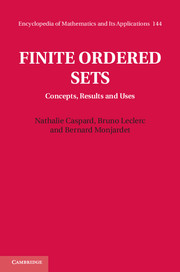Book contents
- Frontmatter
- Contents
- Preface
- 1 Concepts and examples
- 2 Particular classes of ordered sets
- 3 Morphisms of ordered sets
- 4 Chains and antichains
- 5 Ordered sets and distributive lattices
- 6 Order codings and dimensions
- 7 Some uses
- A About algorithmic complexity
- B The 58 types of connected ordered sets of size at most 5
- C The numbers of ordered sets and of types of ordered sets
- D Documentation marks
- References
- List of symbols
- Index
3 - Morphisms of ordered sets
Published online by Cambridge University Press: 05 February 2012
- Frontmatter
- Contents
- Preface
- 1 Concepts and examples
- 2 Particular classes of ordered sets
- 3 Morphisms of ordered sets
- 4 Chains and antichains
- 5 Ordered sets and distributive lattices
- 6 Order codings and dimensions
- 7 Some uses
- A About algorithmic complexity
- B The 58 types of connected ordered sets of size at most 5
- C The numbers of ordered sets and of types of ordered sets
- D Documentation marks
- References
- List of symbols
- Index
Summary
Let P be an ordered set modeling, for instance, a scheduling problem (see Section 7.5 in Chapter 7). The determination of some characteristics of this ordered set, for example its linear extensions, requires the implementation of an algorithm where P is represented by means of an appropriate data structure. In particular, the elements of P may be suitably represented by sequences of symbols 0 and 1 of fixed length r. A condition for this to hold is that, if c(x) and c(y) are the r-sequences representing two elements x and y of P, then c(x) < c(y) if and only if x < y, where the former is the order of the direct product. In particular, the map c from P to this direct product must be order-preserving. This is an example among many others where order-preserving or reversing maps between two ordered sets are needed. This chapter is devoted to the study of such maps, called morphisms. We define several fundamental types of morphisms, such as codings (or embeddings, or mergings), closure and dual closure operators, residuated, residual, and Galois maps. We are concerned with relations between these various types of maps, canonical examples, and natural developments.
Several types of morphisms between ordered sets are defined in Section 3.1, namely isotone (or strictly isotone) maps, antitone maps, and codings, which make a copy of their domain appear in their range set. Such maps will frequently appear throughout this book.
Information
- Type
- Chapter
- Information
- Finite Ordered SetsConcepts, Results and Uses, pp. 67 - 106Publisher: Cambridge University PressPrint publication year: 2012
